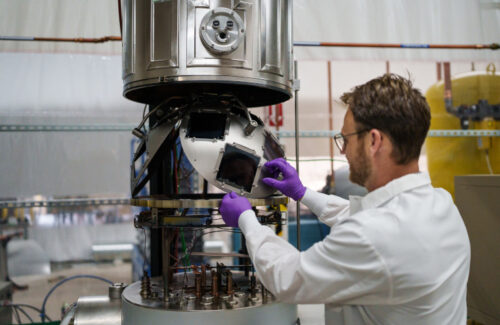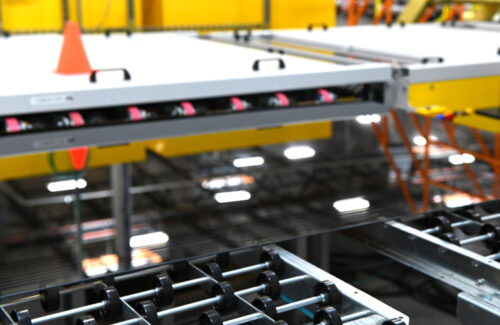During the opening ceremony of this year’s SNEC PV+ conference in China, Trinasolar’s chairman and general manager Jifan Gao said that the ongoing debate on which silicon technology is best — TOPCon, back-contact or HJT — is beside the point when the real future of the solar panel market is tandem perovskite designs. Perovskites are a thin-film material that absorb more of the light spectrum and are highly efficient. When combined with a silicon solar cell, perovskites offer a low-cost, scalable option to boost solar output.
Even the best silicon-only solar cells have likely reached their efficiency limits, but when paired with thin-film perovskite, silicon module efficiencies can exceed 30%. Trinasolar is pioneering perovskite-silicon tandem designs and recently hit a record-setting 30.6% efficiency in the lab. The company has also been breaking its own record every few months on full-sized perovskite-silicon modules, recently exceeding an 840-W output and 27.1% efficiency.
China is positioning itself to dominate another segment in solar with perovskites. Just as the first silicon cell was birthed in the United States before taking off through Chinese R&D, advancements in solar perovskites have become a global effort with commercialization led by Chinese powerhouses like Trinasolar. That doesn’t mean solar perovskite development has been lost to China, though.
“We have a unique historical moment to reset the manufacturing paradigm internationally. One thing that perovskites enable is domestic production — domestic with a capital ‘D,’” said Scott Graybeal, CEO of southern California solar perovskite company Caelux. “It could be anywhere in the world. You have a given market, and it’s possible for you to do perovskite production there. Perovskites give us an opportunity to reset the supply chain.”
That’s because any way you paint it, coat it or embed it — to which there are dozens of perovskite startups all seemingly working in different application processes — thin-film perovskites work with any silicon solar cell to create a new, more powerful solar product. When the entire world is looking for more affordable energy sources, every unique perovskite-silicon tandem solar panel will have a home.
Two California startups may be part of the U.S. perovskite family, but their final products put them at opposite ends of the spectrum. Their individual successes will allow the United States to make its own perovskite-silicon tandem headlines and boost domestic solar production at a perilous time in the industry.
Tandem PV is going for the full package
The first peer-reviewed studies on perovskite-silicon tandem solar panels were published in the mid-2010s by Colin Bailie, then a doctoral candidate at Stanford University. He later founded Tandem PV, a perovskite-focused company in San Jose, California, that is working on a full perovskite-silicon tandem solar panel. After 10 years of R&D and $50 million raised, Tandem PV CEO Scott Wharton said the company plans to have tandem solar panels ready for utility-scale customers in 2026.
“A lot of our competitors are just building a cell or putting perovskite on the cell. Our strategy is different — we’re building the full tandem panel,” he said. “We’ve been working directly with utility-scale developers. A few have invested in us already, and we have incredible feedback. They’re saying, ‘If I get a 28% [efficient] panel from you guys and it’s made in the U.S., why wouldn’t I want it?’ The race is on to fulfill that promise.”
Instead of depositing thin-film perovskite directly on a silicon solar cell, Tandem PV stacks a perovskite-layer between silicon-contacts. The mechanically stacked tandem cell has reached 28% efficiency, the company claims, with expectations to exceed 30% by year’s end. The company’s current R&D tools allow Tandem PV to produce a prototype the size of a tablet. Recent investments and a $4 million grant from the California Energy Commission will enable a demonstration factory and larger panels.
“We’ve ordered all new tools. We’ve got the factory lined up to build out a full-scale panel,” Wharton said. “Our strategy is to do a drop-in replacement, so the same size, same electronics and glass, same encapsulants, just 30% better.”
Wharton said project developers are comfortable with the idea of buying panels directly from Tandem PV because there’s no risk to solar technology in general — developers know how solar panels work, and here’s a company offering a better-performing version.
“We’ve gotten a lot of success on the product side with efficiency and durability. But the real proof is, will the customer buy it? Will they deploy it? There are a lot of announcements about lab [results], but who cares?” he said. “The main thing we’re focused on right now is not setting the world record. But just, can we take a panel that is smaller size and make it bigger? Can we make those efficiency and durability performance levels? Can we replicate it so every panel has it? We’re in the middle of doing that. That’s the risk that we have, but we’re well on the path. Why else would people give us this $50 million to do it?”
Caelux plans to work with silicon panel manufacturers
Just outside Los Angeles, one U.S. company has shipped its first commercial order of perovskite-coated glass to an unnamed solar panel manufacturer for use in an upcoming domestic project. Caelux used $24 million in funding to outfit a perovskite-coated glass factory that within two years delivered the product it has nicknamed Active Glass.
“We produce this device that’s used to create a hybrid, tandem module. We needed a name for the sheet of glass that we deposit our stack on,” Graybeal said. “It’s active glass. It does something more than just [be transparent]. We take light and produce electrons.”
Caelux’s perovskite-coated glass will act as a traditional silicon solar panel’s front glass, which can be dropped into an existing panel manufacturer’s assembly line. The boosted glass only needs a few pieces of pre-installed charge collection tape attached at the bussing station.
“We didn’t want to make it hard for the module manufacturer, because those lines run full-out,” Graybeal said. “One of our early taglines was ‘solar simplified.’ We work with customers regardless of cell type. They give us a voltage specification and junction box layout. We take that information and that informs where we put our cell tape that becomes the connection. We’ve found that’s the best way to do it — to be a partner with your customer.”
Instead of producing a perovskite-silicon tandem solar panel outright, Caelux has chosen to focus only on the perovskite element. The company claims to enable up to 6% efficiency improvement, but the rest is dependent on the base silicon product. Caelux’s first module partner wasn’t named, but India’s Reliance New Energy was an early investor.
“Partnering with these big module players is super helpful, because they have the resources and can give you feedback,” Graybeal said. “We’re here to ensure that our downstream customers can generate more energy harvest, especially given the headwinds that have been thrown in front of them. I think optimizing domestic content and optimizing production in the field is going to be really important.”
The rollback of incentives in the U.S. solar market might be an opportunity for perovskite companies like Caelux, Graybeal said.
“The implications associated with the ITC will have an impairment on the market size. Let’s say the U.S. market cuts in half and goes from 50 GW to 25 GW — that’s still huge for us. That’s still massive,” he said. “I think we have a technology that’s going to enable developers to better leverage these fewer projects but with better performing projects. We reduce the install costs by about 14% and boost the cash flows for a project by 45% in the United States. These are all healthy things to have in a less subsidized environment.”
Caelux is working on more orders and intends to have a more formal product launch later this year. While the company is glad to be one of the first perovskite startups in the United States to come to market, Graybeal said the opportunities for perovskites are exciting across the board.
“When we get together at tradeshows, there’s a little perovskite knot of people who tend to find each other. We’re all cheering for one another ultimately,” he said. “I can see, longer-term, a wholesale transition of the market to perovskite-type thin-film technologies. We may be able to look at these technologies on par with crystalline silicon at some point.”




